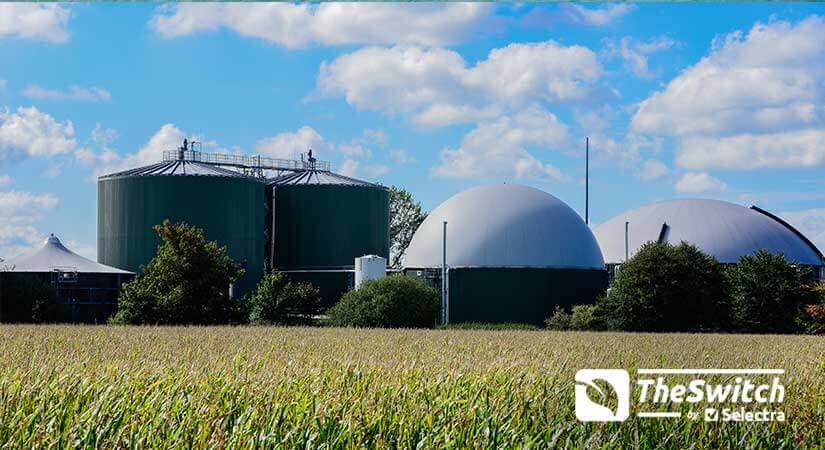What is biomass & is it green? A complete guide

Biomass refers to organic materials coming from plants, animals or human activity. Biomass matter can be burned or processed to release energy, and could form part of a sustainable future in which we're able to rid ourselves of our reliance on fossil fuels. Learn more about biomass energy, including where it comes from and how we process it, in our complete guide.

What is biomass?
Biomass is plant or animal-based material that can be used as a sustainable source of energy. Wood is probably the best-known example of biomass, and has been used as a source of heat and combustion for almost as long as humans have walked the earth.
Other examples of biomass include energy crops which are purposefully planted and then harvested to produce energy. Poplar, silvergrass and willow are the most common energy crops in the UK. Let’s take a look at how they are used, as well as the other main sources of biomass for energy purposes.
What are 5 types of biomass
Here is a list of the five sources of biomass energy:
- Wood energy crops such as poplar and willow can be burnt in a combined heat and power plant or in a compatible residential boiler.
- Other energy crops such as purpose-grown grasses and corn can be processed into fuels like bioethanol, and some algae produce a fat which can be converted into biodiesel, the most common type of biofuel.
- Agricultural waste, usually from farms or slaughterhouses, such as excess fertiliser, pesticides, slurries, straw and manure can either be burned or anaerobically digested to make methane. This can be processed further into natural gas and injected into the UK gas network to generate either electricity or heat.
- Industrial waste from construction projects can be used in an anaerobic digestion facility. Burning waste to generate electricity or heat can make environmental sense if emissions and residues are handled with care, as it means landfill waste can then be reduced.
- Municipal waste, either commercial or residential, such as garden waste, food waste, paper, cardboard, plastics, rubber, leather and textiles. Using this waste for bioenergy also represents an opportunity to reduce residential and commercial waste by diverting significant volumes from landfills to the refinery.
Advantages of biomass

The advantages of biomass are the following:
- Always and widely available
- Carbon neutral
- Reduces overreliance on fossil fuels
- Less expensive than fossil fuels
- Added revenue source for manufacturers
- Less rubbish filling up landfills
Disadvantages of biomass
The disadvantages of biomass are the following:
- Not as efficient as other energy sources
- Not entirely clean
- Can lead to deforestation
- Energy crops require a lot of space
Pyramid of biomass
The pyramid of biomass is how energy flows through the food chain of an ecosystem and is not related to renewable energy production.
The idea is that the amount of biomass goes down as you move up the food chain. It’s a measure of dry matter per square foot or metre cubed. In a pyramid of biomass, animals are divided into consumers and producers depending on whether they are predators or prey. Humans are part of a pyramid of biomass too!
How to use biomass
Biomass doesn’t produce heat on its own; it needs to be processed to unlock its potential energy. Let’s take a look at how biomass is processed to generate power.
Treating biomass with heat
Technically known as a thermal conversion, heat is used to process the biomass into more usable fuel. There are three main methods:
- Torrefaction takes out the moisture from biomass by heating it up in an oxygen-free environment (same as with roasting coffee). The result is often named bio-coal which can be shaped into pellets that can be burned to release heat.
- Burning biomass can produce charcoal and carbonized products.
- Gasification exposes biomass to high temperatures and precise quantities of oxygen and steam to convert it into a gas.
Anaerobic digestion plants
Biomass feedstock is placed in an anaerobic digester so that it can produce biogas which can be used to produce electrical power or heat. Alternatively, biogas can be further processed into biomethane or green gas.
The anaerobic digester plays a central role in the processing of biomass from a variety of sources:
- Vegetable residues and crops
- Food and other organic waste
- Agricultural slurry and manure
Anaerobic digesters are essentially sealed composting tanks operating at industrial scales. Biomass is placed in the digester so it can break down into various by-products, the most valuable of which is biogas which will automatically rise to the top.
These composting stacks have a set of blades at the bottom to mix up the biomass and encourage decomposition. Several valves and pipes control the pressure levels and biomass composition within the vessel, as well as allowing convenient extraction of effluent biogas as well as liquid and solid digestate.
The biogas can then be either used directly to produce heat or power in compatible facilities, or refined into biomethane which is essentially indistinguishable from natural gas, making it ideal for the gas grid or LPG vehicles.
What is digestate?
While digestate is not the primary product of the anaerobic process, it is a nutrient-rich material that can be repurposed into fertiliser. Since it’s made up of whatever was left after biogas has been extracted, digestate is a 90% match to the biomass feedstock that was introduced in the first place.
Digestate is not to be confused with compost. Even if there are a few similarities, compost is produced by air-breathing (aerobic) bacteria and microorganisms breaking down compostable materials (which could be used for biogas production too):
- Green waste
- Animal manure and bedding
- Human waste
The key thing to remember is that whatever nitrogen and potassium present in the original biomass will remain intact in the digestate byproduct. This means that digestate can be effectively used as a fertiliser. Digestate-based fertilisers are essential to managing our carbon footprint and reducing fossil fuel consumption. However, digestate isn’t the end goal when it comes to anaerobic digestion. Let’s take a closer look at biogas.
Biogas and Green gas
Biogas is the primary product resulting from biomass processing in an anaerobic digester. It is predominantly made up of methane and carbon dioxide. In this form, biogas is not immediately compatible with the natural gas specifications of the natural gas grid.
Without modification, biogas can be used in combined heat and power plants, which represents the most energy-efficient case use with escaped heat energy being repurposed to feed the heating system. Combined heat and power plants have been successfully miniaturised to the point that they can be used to heat or power single office or residential buildings.
However, biogas cannot be injected as is into the UK gas grid. To do so, it must undergo a cleaning process to remove harmful and incompatible substances which could damage everything: from gas infrastructure to household appliances. These include:
- Oxygen
- Hydrogen sulphide
- Water
- Nitrogen
- Carbon dioxide
Once those elements and compounds are removed, the gas’s calorific value has to be increased and then odorised for safety reasons, namely so that gas leaks can be easily detected. At this point, biogas has been turned into biomethane or green gas which is fully compliant with grid gas norms.
Biomethane and Green Gas are interchangeable terms that refer to biogas that has been upgraded for national gas grid use.
Recent figures point to around 90 biomass plants currently generating biogas or green gas in the UK. It is estimated that the number of British homes supplied with green gas has surpassed the one million mark and this represents a 150% increase in supply when compared to 2018.
Just like with green electricity and the Renewable Energy Guarantees of Origin (REGO), green gas producers comply with an equivalent system under the Green Gas Certification Scheme (GGCS) to track the use of green gas.
Biomass boiler and heating systems
A biomass boiler can burn wood pellets or even whole logs to do the same things you would expect from a conventional boiler (hot water and heating) but with a different and more sustainable fuel.
Biomass heating systems have an added benefit for farming or gardening households. Every month or so, this type of boiler needs to have its ash build-up removed to ensure trouble-free operation. However, this ash is nutrient-rich and can be added directly to your compost heap to make your garden or plot even greener.
It’s worth noting that a biomass boiler is significantly larger than its standard counterparts or even heat pump alternatives. Its large size is mainly due to fuel storage needs and the necessity of a larger combustion chamber.
The UK is faced with dwindling national gas supplies (from the North and Irish seas), which can only mean an increasing reliance on costly natural gas imports. The Biomass Energy Centre compared the cost of different fuel types for heating and hot water purposes, and their figures are quite revealing:
| Fuel Type | Price per Unit | kWh per unit | Pence per kWh |
|---|---|---|---|
| Wood Chips | £100 / tonne | 3,500kWh / tonne | 2.9p / kWh |
| Wood Pellets | £200 / tonne | 4,800kWh / tonne | 4.2p / kWh |
| Natural Gas | 4.8p / kWh | 1 | 4.8p / kWh |
| Heating oil | 60p / litre | 10kWh / litre | 6.0p / kWh |
| Electricity | 13.4p / kWh | 1 | 13.4p / kWh |
Burning wood products may not seem that environmentally friendly on the face of it, but it’s worth considering that over 8 million tonnes of wood are being chucked in landfills all over the UK. Not only is this wasteful but it also overloads landfill capacity.
With this in mind, using excess wood to heat rural homes that don’t have easy access to the gas grid is clearly the better option both in terms of cost and sustainability.
Biomass UK sites
UK green gas production has quadrupled since 2015 and is expected to top 2.5TWh this year, which represents over 8% of the electricity mix. Biomass is second only to combined onshore and offshore wind energy when looking at the UK renewable energy mix. The good news is that biomass is all set to overtake coal in the UK energy mix. Let’s take a quick look at two key players in the UK biomass domain.
Pentland Biomass
Pentland is an established wood chip and pellet manufacturer for biomass applications. The company sells both the finished product and is able to process trees provided by clients. Additionally, they also design and install biomass-based heating systems for commercial customers.
The company has two high-powered wood chippers that operate either on their premises or are available for hire. They are able to turn 35 to 60 tonnes of wood into wood chips every hour.
Find out more about Pentland Biomass.
Templeborough Power Plant
The Templeborough Biomass plant opened its doors in mid-2018 after a three-year construction process and began delivering electricity to the grid earlier in 2019. Unlike Biogas plants, Templeborough burns wood to generate over 40 MW of electricity while remaining mostly energy independent for its processing needs.
Burning wood might seem environmentally-unfriendly at first glance but it is actually very close to being carbon neutral. Wood materials lock in energy and CO2 meaning that, unlike coal and other fossil fuels, no additional or new greenhouse gases are being put out into the atmosphere.
Find out more about Templeborough.
Energy companies that use biomass energy
With biomass’ rapidly growing profile in the UK energy landscape, it’s no surprise that there are over 60 energy companies using biomass energy as part of their supply in some capacity. Let’s have a look at some notable examples.
- Green Energy UK is the only UK energy provider to claim that it only supplies biomethane to its customers. Their CEO, Doug Stewart, recently reported that there has been “a strong surge in demand”. With over 20,000 customers, Green Energy UK is a solid choice for residential customers looking for sustainable energy.
- Ecotricity has been vocal about wanting to build their anaerobic digesters to generate green gas. They applied for planning permission in 2015, but as of 2019, their first site at Sparsholt College near Winchester is still awaiting construction. While the anaerobic digestion plants haven’t materialised yet, Ecotricity does guarantee that their natural gas does not come from fracking.
- Tonik currently ensures that 10% of the gas they supply is biomethane. For the remaining 90%, they compensate its environmental impact through carbon offsetting (guide soon).
- Npower matched up to 15% of the gas they supplied through their Go Green Energy Fix tariff in 2019. They have unfortunately discontinued this practice for their current iteration of this fixed tariff.
- Bulb, just like Tonik Energy, is able to source 10% of their gas from green sources while the environmental impact from the remaining 90% is compensated by carbon offsetting once again
- Ovo Energy buys enough green gas certificates to cover 15% of gas consumption for customers who pay a £5 surcharge. Meanwhile, this monthly fee also covers the carbon offset of the remaining 85% of the gas supply, much like with Tonik and Bulb.
- Good Energy has a similar story to tell with 6% of their gas coming from green sources, while the remainder is carbon offset through verified carbon reduction schemes in Asia, fostering access to clean energy in Vietnam and Nepal.
- Bristol Energy encourages independent and community generators to partner with them through Power Purchase Agreements. They support local projects like GENeco to bring their customers 15% green gas as part of their fuel mix.
